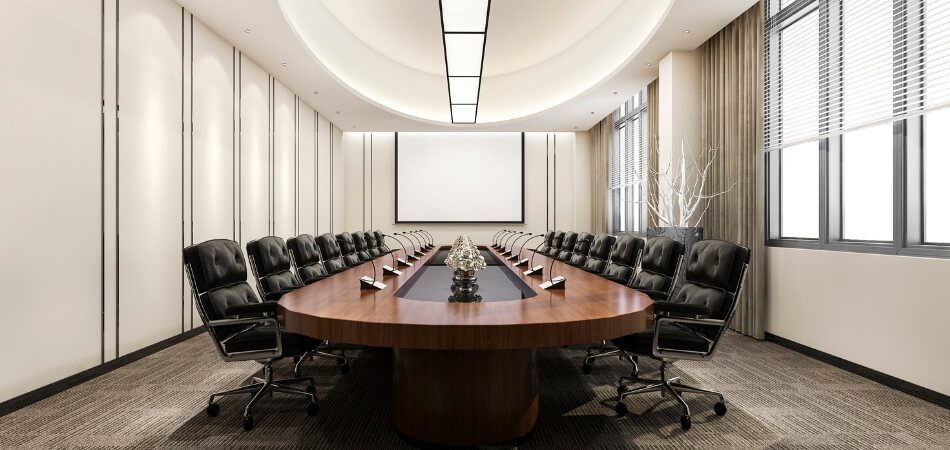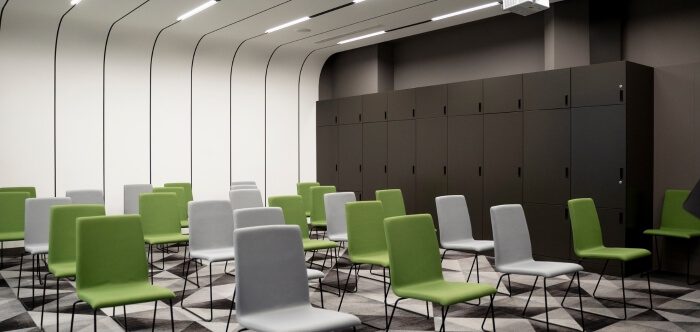The modern business landscape is increasingly reliant on effective communication and collaboration, choosing conference room technology more crucial than ever. This is where the “6 best conference room technologies” come into play, bridging the gap between traditional meeting environments and the digital era’s dynamic needs.
These technologies not only streamline collaboration but also enhance the overall meeting experience, fostering productivity and engagement. From state-of-the-art audiovisual equipment to advanced connectivity solutions, these tools are essential for any organization looking to optimize its conference space.
By incorporating these technologies, businesses can overcome common meeting challenges and unlock new levels of efficiency and innovation in their team interactions.
What are Essentials for a Conference Room?
A well-equipped conference room is a cornerstone of modern business, facilitating effective communication and collaboration. The right mix of technology and comfort can transform meetings into productive, engaging experiences. Here are key essentials for an optimal conference room setup.
- High-Quality Audio System: Clear audio is fundamental for effective communication. A top-notch audio system ensures everyone’s voice is heard, regardless of their location.
- Reliable Video Conferencing Equipment: With remote work on the rise, video conferencing is indispensable. Ensure your system delivers high-definition visuals and stable connectivity.
- Interactive Whiteboard: This tool enhances brainstorming sessions by allowing real-time collaboration. Digital whiteboards can save and share the content of the meeting instantly.
- Comfortable Seating: Ergonomic chairs provide comfort during long meetings. Comfort is key to maintaining focus and engagement among participants.
- Efficient Lighting: Good lighting is crucial for visibility and reducing eye strain. Adjustable lighting systems can adapt to various times of day and meeting types.
- Robust Internet Connection: A strong, reliable internet connection is non-negotiable. It supports all digital tools and ensures seamless online interactions.
- Accessible Power Outlets: Adequate power outlets keep devices charged and operational. Strategically placed outlets enhance convenience and reduce clutter.
- Soundproofing Elements: Soundproofing maintains confidentiality and minimizes external distractions. It ensures discussions remain within the room.
- Climate Control: A comfortable temperature aids concentration. Adjustable climate control caters to diverse preferences, enhancing overall comfort.
A well-appointed conference room is more than just a meeting space; it’s a productivity hub. By integrating these must-have conference room technologies, businesses can create an environment that promotes efficiency, comfort, and collaboration, driving success in today’s fast-paced world.
6 Best Conference Room Technologies
A proper arrangement requires technical support, no matter whether it’s a conference or virtual meeting. So, let’s expand our knowledge of these technologies to provide a more comprehensive understanding of their role in modern conference rooms.
1. Digital Whiteboards
Digital whiteboards are pivotal in transforming traditional meetings into interactive sessions. They enable participants to collaborate in real-time, drawing, writing, or annotating directly on the board. This interactivity fosters a more engaging and inclusive meeting environment.
Besides, these whiteboards often integrate with various software, allowing users to access files from the cloud, play videos, and even conduct web searches. This versatility turns the whiteboard into a multi-functional tool, suitable for a wide range of meeting types. Plus, their ability to save and share the content instantly ensures that no idea gets lost after the meeting ends.
2. Meeting Room Displays
High-quality displays are essential for effective visual communication in any modern meeting space. These screens, often ranging from large flat panels to interactive touchscreens, provide crystal-clear visuals that are vital for detailed presentations. They can be seamlessly integrated with video conferencing tools, ensuring that remote participants have the same visual experience as those in the room.
Moreover, the compatibility of these displays with various digital formats, from PowerPoint presentations to high-definition videos, makes them incredibly versatile. Also, ensure the most appropriate projector position in conference room for better viewing. Advanced models also include features like screen mirroring and multi-screen display, enhancing the collaborative experience by allowing multiple users to share content simultaneously.
3. Voice-Recognition Technology
Voice-recognition technology brings efficiency and accessibility to meeting spaces. By enabling voice commands, this technology allows users to control various aspects of the meeting environment hands-free, from adjusting the thermostat to changing slides. This not only streamlines the meeting process but also makes the space more accessible to individuals with different abilities.
Additionally, the integration of voice-to-text features is invaluable for record-keeping. It provides real-time transcription of meetings, making it easier to review discussions and share meeting notes. This technology is also evolving to understand and execute more complex commands, making meetings more interactive and less reliant on manual controls.
4. AI-Powered Cameras
AI-powered cameras in conference rooms are redefining the video conferencing experience. These cameras use artificial intelligence to optimize the video feed, focusing automatically on the speaker and adjusting the frame to include all participants. This dynamic framing ensures that remote attendees have a more engaging and inclusive view of the meeting.
Additionally, some AI cameras come with features like facial recognition and gesture recognition, adding a layer of personalization and interactivity to virtual meetings. They also adjust to varying light conditions, ensuring high-quality video output regardless of the time of day or room lighting, thus making remote communication more effective and lifelike.
5. Wireless Connectivity
Wireless connectivity is the backbone of modern conference technology. A robust wireless network enables participants to connect various devices from laptops to smartphones without the clutter of cables. This facilitates easy sharing of content and collaborative work, as attendees can present or contribute from their seats.
Advanced wireless solutions also support higher bandwidths, accommodating simultaneous streaming of high-definition videos and large file transfers. Furthermore, the integration of wireless charging stations for devices adds to the convenience, ensuring that all devices remain powered throughout the meeting. The emphasis on seamless, reliable connectivity reflects the growing need for uninterrupted digital collaboration in business environments.
6. Smart Lights
Smart lighting systems in conference rooms do more than just illuminate the space; they enhance the overall meeting experience. These lights can be programmed to change intensity and color temperature, adapting to different meeting scenarios. For instance, a brightly lit room is ideal for detailed analytical work, while a softer, warmer light can create a relaxed atmosphere for brainstorming sessions.
Smart lights also contribute to energy efficiency, as they can adjust based on natural light availability or be programmed to turn off when the room is not in use. The ability to control lighting via mobile apps or voice commands further adds to the convenience, allowing for on-the-fly adjustments to suit the meeting’s mood and focus.
These six technologies represent the forefront of conference room innovation, each playing a unique role in enhancing communication, collaboration, and efficiency. Their integration into modern meeting spaces is not just a trend but a necessity for businesses looking to thrive in a digitally connected world. By adopting these technologies, organizations can ensure that their meeting spaces are not only functional but also conducive to productive and engaging interactions.
Benefits of Having the Required Technologies in a Conference Room
Equipping a conference room with the latest technologies is not just a matter of keeping up with trends; it’s about enhancing the productivity and effectiveness of meetings. In a world where communication and collaboration are key to business success, these technologies play a pivotal role. Let’s delve into the specific benefits that these advanced technologies bring to a conference room setting.
Enhanced Collaboration and Participation
Implementing cutting-edge technologies like digital whiteboards and AI-powered cameras fosters a more collaborative environment. Digital whiteboards enable real-time sharing and editing of ideas, making brainstorming sessions more dynamic and inclusive.
AI-powered cameras, on the other hand, ensure that remote participants are seen and heard clearly, bridging the gap between physical and virtual presence. This integration of technology ensures that every participant, whether in the room or joining remotely, can actively engage and contribute to the meeting.
Increased Efficiency and Time Management
Incorporating technologies like voice-recognition systems and wireless connectivity streamlines meeting processes, significantly saving time. Voice-recognition systems allow for quick adjustments to equipment settings without interrupting the meeting flow.
Wireless connectivity facilitates seamless sharing of content from various devices, reducing the time spent on setting up presentations and troubleshooting connectivity issues. This efficiency in handling technical aspects means meetings can start on time and stay focused on the agenda, maximizing the productivity of the time spent together.
Improved Presentation Quality
High-quality meeting room displays and sound systems significantly enhance the quality of presentations. Crisp, clear visuals on state-of-the-art displays ensure that all attendees, irrespective of their position in the room, can easily view the content. The overall presentation quality depends largely on choosing the right TV for your conference room.
Superior sound systems deliver clear audio, making it easier for participants to follow discussions without straining to hear. These technologies collectively ensure that the content presented is communicated effectively, making meetings more impactful and informative.
Creating a Conducive Meeting Environment
Smart lighting systems and ergonomic design elements contribute significantly to creating a comfortable meeting environment. Smart lights can be adjusted to suit the nature of the meeting, whether it requires bright light for focus or softer lighting for creative brainstorming.
Ergonomic chairs and well-designed room layouts ensure physical comfort, reducing fatigue during long sessions. This attention to comfort not only enhances the overall meeting experience but also helps in maintaining the focus and engagement of the participants.
By investing in these technologies, businesses are not just upgrading their physical space, but they are also investing in their team’s collaboration, productivity, and overall satisfaction. This strategic approach to meeting space design is crucial for any organization aiming to thrive in the current competitive and fast-paced business environment.
Considerations While Selecting a Room for a Conference
Selecting the right room for a conference is a critical decision that can greatly impact the success of the event. It’s not just about finding a space; it’s about ensuring the environment is conducive to the meeting’s objectives. Key considerations need to be addressed to create an effective and comfortable conference setting.
- Size and Capacity: The room should comfortably accommodate all attendees. Ensure there’s enough space for seating, walking, and any necessary equipment.
- Location and Accessibility: Choose a location that’s easily accessible for all participants. Consider proximity to public transport, parking availability, and accessibility for individuals with disabilities.
- Acoustics and Soundproofing: Good acoustics are crucial for clear communication. Select a room with soundproofing to avoid external noise disturbances.
- Technology Infrastructure: Ensure the room has the necessary technical infrastructure. This includes reliable Wi-Fi, audiovisual equipment, and charging stations.
- Natural Lighting and Ventilation: A well-lit room with natural light can boost energy and focus. Adequate ventilation is also important for maintaining a comfortable environment.
- Furnishing and Comfort: The furniture should be ergonomic and comfortable. Chairs and tables must be suitable for the duration and nature of the conference.
- Privacy and Security: Privacy is key for confidential meetings. Choose a space that offers security and privacy from external interruptions.
- Flexibility and Layout Options: Look for a room that offers flexible layout options. This adaptability is important for different types of meetings and activities.
Carefully considering these factors when selecting a conference room can lead to more productive and enjoyable meetings. The right environment not only supports the meeting’s goals but also enhances the overall experience of the participants.
Frequently Asked Questions
In this section, we answer some of the most common questions about conference room technologies. Whether you’re looking for guidance on choosing the right tools or curious about how these technologies can enhance meetings, we’ve got you covered. Our FAQs will help you navigate the world of conference room tech and make informed decisions for your space!
What technology do you need in a conference room?
A well-equipped conference room should have essential technology like a large-screen TV or projector, a powerful sound system, a video conferencing system, and reliable Wi-Fi. These tools ensure smooth meetings, clear communication, and a professional atmosphere.
What is a smart conference room?
A smart conference room is a technologically advanced space that seamlessly integrates various devices and systems. Imagine a room where you can effortlessly start a video conference, share documents wirelessly, control the lighting and temperature, and even schedule meetings with voice commands. It’s like having a personal assistant at your disposal during meetings.
What are the modern methods of conference?
Modern conferences have evolved beyond traditional in-person gatherings. Virtual conferences, webinars, and hybrid events offer flexibility and accessibility. Participants can connect from anywhere, saving time and resources. These online platforms also enable interactive features like live Q&A sessions and virtual networking.
How is technology used in meetings?
Technology has transformed the way we meet. Video conferencing, online collaboration tools, and document-sharing platforms have made it easier to connect with colleagues from anywhere in the world. These tools streamline communication, improve productivity, and reduce the need for travel.
How many devices can be used for video conferencing?
The number of devices that can be used for video conferencing depends on the specific platform and your internet connection. Most platforms allow multiple participants to join from different devices, such as computers, laptops, tablets, and smartphones. However, the quality of the video and audio may vary depending on the number of participants and the internet speeds of each device.
Final Words
The integration of the “6 best conference room technologies” is not just a luxury but a necessity for any forward-thinking organization today. These technologies, ranging from digital whiteboards to smart lighting systems, are pivotal in enhancing collaboration, efficiency, and the overall quality of presentations.
They play a crucial role in transforming a traditional meeting space into a dynamic and interactive hub, conducive to both in-person and remote participation. By thoughtfully selecting a conference room equipped with these essential technologies, and considering factors like size, location, and infrastructure, businesses can significantly improve the productivity and effectiveness of their meetings.
Ultimately, this strategic approach to conference room design and technology integration stands as a testament to an organization’s commitment to excellence and innovation in today’s competitive business landscape.








